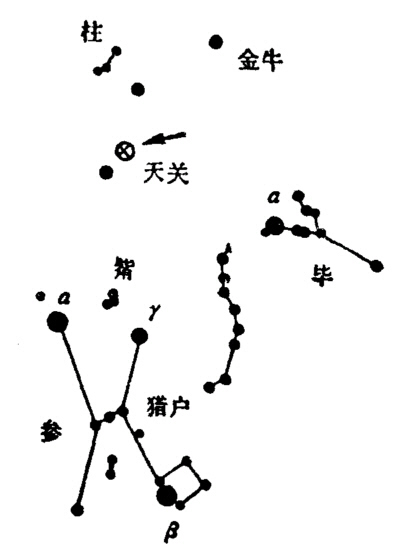Chapter 20 Section 6 Nova and Supernova
Both nova and supernova are variable stars, which are explosive variable stars.When a nova explodes, its brightness can increase by thousands to tens of thousands of times within a few days, and then slowly dim, and usually after several years or decades, it returns to the brightness before the explosion.The scale of the supernova explosion is larger, and the brightness is increased by tens of millions or even hundreds of millions of times.
There are more than 50 reliable records of novas and more than 10 supernovae in ancient China.The earliest record of supernova can be found in "Hou Han Shu Astronomical Records": "In the second year of Zhongping (185 A.D.) in October Guihai, the guest star came out of the south gate. It was as big as a half-feast, with five colors of joy and anger. It will disappear in June of the next year." "Nanmenzhong" roughly corresponds to the star Beta Centauri in the modern star chart. Not far from the southeast of Star Beta, it has been confirmed that there is a radio source, and it is very likely that it is the " "Guest Star" legacy.

Figure 13 Location map of Tianguan guest star
In the search for the correspondence between ancient supernovae and modern optical celestial bodies, the 1054 supernova was the first to be confirmed.According to "Song Huiyao" records: "In the first year of Zhihe, in May, he went out to the east in the morning and guarded the Tianguan. He saw it like Taibai in the daytime, with horns and horns protruding in all directions, and his color was red and white. He saw it for twenty-three days." month, which corresponds to June and July in 1054 AD, and the star of Tianguan is Taurus ξ (see Figure 13).This is the observation record of Si Tianjian at that time. In 1731, British astronomer Beavis found an oval fog spot in this position with a small telescope. In 1844, the British WP Ross observed its fibrous structure through a large telescope, and named it the Crab Nebula according to its appearance. In 1921, American Duncan studied two groups of photos separated by 12 years, and was surprised to find that the Crab Nebula was expanding. In 1942, Dutch astronomer JHOort deduced from the expansion speed of the nebula that these fibrous substances were scattered from a dense point about 900 years ago.After many calculations and analyzes by astronomers, it is confirmed that the Crab Nebula is the remnant of the supernova explosion in 1054. In 1969, another pulsar was discovered in the Crab Nebula.As early as 1934, the German astronomer W. Baade had theoretically predicted that after a supernova exploded, its central part would collapse and become a neutron star with small size, high density and fast rotation.The physical characteristics reflected by this pulsar are in perfect harmony with the predictions.It shows that there was indeed a supernova explosion, thus confirming the reason for the formation of the Crab Nebula from another aspect.The discovery of neutron stars became one of the four major discoveries in astronomy in the 1960s.
Compared with any country in the world, China has a large number of records on strange astronomical phenomena, which are the most reliable and complete, and from the perspective of data, the availability rate is the highest.Ancient records serve modern scientific research, which is something that astrologers never thought of.In the future, when the science develops further, these records may show even greater value.

Figure 13 Location map of Tianguan guest star
